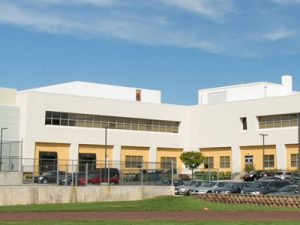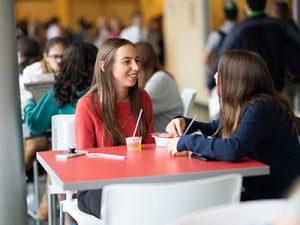Integrating Nach, Yamim Noraim and Studio Art at Frisch: Like Clay in the Hands of the Potter
October 5, 2017
 Last week, tenth grade Nach classes at Yeshivat Frisch had the opportunity to learn about the classic phrase “kachomer be-yad ha-yotzer”—“like clay in the hands of the potter”—through a multidisciplinary lesson combining limudei kodesh, art history and studio art experience.
Last week, tenth grade Nach classes at Yeshivat Frisch had the opportunity to learn about the classic phrase “kachomer be-yad ha-yotzer”—“like clay in the hands of the potter”—through a multidisciplinary lesson combining limudei kodesh, art history and studio art experience.
The phrase “like clay in the hands of the potter” appears in the classic, medieval piyyut titled “Ki Hineh Ka-Chomer,” which Jewish congregations around the world sang just a few days ago during Yom Kippur davening. The piyyut draws vivid parallels between Am Israel’s relationship with God and the vulnerability of various physical materials in the hands of craftsmen and artisans. The first stanza compares Israel to clay: “Like clay in the hands of the potter/He expands it at will and contracts it at will/So are we in Your hand, O Preserver of kindness/Look to the covenant, and ignore the accuser.”
However, the piyyut draws its inspiration from chapter 18 in the Book of Jeremiah, which Frisch sophomores are currently learning in Nach class. In this chapter, the prophet Yirmiyahu is commanded to go to the potter’s house and watch the craftsman at work. Yirmiyahu observes that the fate of nations and individuals rests in divine hands: “O house of Israel, cannot I do with you as this potter? says the Lord. Behold, as the clay in the potter’s hand, so are you in My hand, O house of Israel” (18:6).
To understand why this metaphor is so apt, students visited Frisch’s in-school art studio, run by Ahuva Winslow, director of the school’s art department. There, the students tried their own hands at pottery-making. “What does the clay do when you work with it?” Winslow asked the students to consider. “What is its texture like? When you push against it and form it into different shapes, does it push back?”
“To be able to experience the concept in the way that Hashem had brought it to Yirmiyahu was a great way to understand the lesson Hashem was trying to teach first hand,” said Noah Schultz, ‘20.
“Until the clay dries, you still have free will to change your fate through your actions, whether for good or for bad” added Sadie Engelsohn, ’20, “This project was a great way to learn about it and remember it.”
Before working with the clay, students also received a mini art history lesson from Winslow. Viewing Michelangelo’s painting of The Creation of Adam, they discussed how the Renaissance painter represented the relationship between God and man and how it compares with our own understanding of that relationship.






 Last week, tenth grade Nach classes at Yeshivat Frisch had the opportunity to learn about the classic phrase “kachomer be-yad ha-yotzer”—“like clay in the hands of the potter”—through a multidisciplinary lesson combining limudei kodesh, art history and studio art experience.
Last week, tenth grade Nach classes at Yeshivat Frisch had the opportunity to learn about the classic phrase “kachomer be-yad ha-yotzer”—“like clay in the hands of the potter”—through a multidisciplinary lesson combining limudei kodesh, art history and studio art experience.